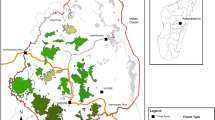Abstract
Although it is well known that frugivorous spider monkeys (Ateles geoffroyi yucatanensis) occupy large home ranges, travelling long distances to reach highly productive resources, little is known of how they move between feeding sites. A 11 month study of spider monkey ranging patterns was carried out at the Otochma’ax Yetel Kooh reserve, Yucatán, Mexico. We followed single individuals for as long as possible each day and recorded the routes travelled with the help of a GPS (Global Positioning System) device; the 11 independently moving individuals of a group were targeted as focal subjects. Travel paths were composed of highly linear segments, each typically ending at a place where some resource was exploited. Linearity of segments did not differ between individuals, and most of the highly linear paths that led to food resources were much longer than the estimate visibility in the woodland canopy. Monkeys do not generally continue in the same ranging direction after exploiting a resource: travel paths are likely to deviate at the site of resource exploitation rather than between such sites. However, during the harshest months of the year consecutive route segments were more likely to retain the same direction of overall movement. Together, these findings suggest that while moving between feeding sites, spider monkeys use spatial memory to guide travel, and even plan more than one resource site in advance.




Similar content being viewed by others
References
Altmann J (1974) Observational study of behavior: sampling methods. Behaviour 49:227–267
Batschelet E (1981) Circular statistics in biology. Academic, London
Boinski S (1987) Habitat use by squirrel monkeys (Saimiri oerstedi) in Costa Rica. Folia Primatol 49:151–167
Chapman CA, Wrangham RW, Chapman LJ (1995) Ecological constraints on group size: an analysis of spider monkey and chimpanzee subgroups. Behav Ecol Sociobiol 36:59–70
Cunningham E, Janson C (2007) A socioecological perspective on primate cognition, past and present. Anim Cogn. doi:10.1007/s10071-007-0078-3
Di Fiore A, Suarez SA (2007) Route-based travel and shared routes in sympatric spider and woolly monkeys: cognitive evolutionary implications. Anim Cogn. doi:s10.1007/s10071-007-0067-x
Etienne AS, Berlie J, Georgakopoulos J, Maurer R (1998) Role of dead reckoning in navigation. In: Healy S (ed) Spatial representations in animals, Oxford University Press, Oxford, pp 54–68
Fedigan LM, Baxter MJ (1984) Sex differences and social organization in free-ranging spider monkeys (Ateles geoffroyi). Primates 25:279–294
Garber PA (2000) Evidence for the use of spatial, temporal and social information by some primate foragers. In: Boinski S, Garber P (eds) On the move. How and why animals travel in groups, The University of Chicago Press, Chicago, pp 165–203
Gibeault S, MacDonald SE (2000) Spatial memory and foraging competition in captive western lowland gorillas (Gorilla gorilla gorilla). Primates 41:147–160
Janson CH (1998) Experimental evidence for spatial memory in foraging wild capuchin monkeys, Cebus apella. Anim Behav 55:1229–1243
Janson C (2000) Spatial movement strategies: theory, evidence and challenges. In: Boinski S, Garber P (eds) On the move. How and why animals travel in groups, The University of Chicago Press, Chicago, pp 165–203
Janson CH, Byrne R (2007) Understanding resource cognition in wild primates—opening the black box. Anim Cogn. doi:10.1007/s10071-007-0080-9
Janson CH, Di Bitetti MS (1997) Experimental analysis of food detection in capuchin monkeys: effects of distance, travel speed, and resource size. Behav Ecol Sociobiol 41:17–24
Ludvig N, Tang HM, Echenbaum H, Gohil BC (2003) Spatial memory performance of freely moving squirrel monkeys. Behav Brain Res 140:175–183
MacDonald SE (1994) Gorillas’ (Gorilla gorilla gorilla) spatial memory in a foraging task. J Comp Psychol 108:107–113
MacDonald SE, Agnes MM (1999) Orangutan (Pongo pygmaeus abelii) spatial memory and behavior in a foraging task. J Comp Psychol 113:213–217
MacDonald SE, Pang JC, Gibeault S (1994) Marmoset (Callithrix jacchus jacchus) spatial memory in a foraging task: win-stay versus win-shift strategies. J Comp Psychol 108:328–334
Menzel EW (1973) Chimpanzee spatial memory organization. Science 182:943–945
Menzel CR, Savage-Rumbaugh SE, Menzel Jr EW (2002) Bonobo (Pan paniscus) spatial memory and communication in a 20-hectare forest. Int J Primatol 23:601–619
Ramos-Fernández G, Boyer D, Gómez VP (2006) A complex social structure with fission–fusion properties can emerge from a simple foraging model. Behav Ecol Sociobiol 60:536–549
Symington MM (1988) Demography, ranging patterns, and activity budgets of the black spider monkeys (Ateles paniscus chamak) in the Manu National Park, Peru. Amen J Primatol 15:45–67
van Roosmalen MGM, Klein LL (1988) The spider monkeys, Genus Ateles. In: Mittermeier RA, Rylands AB, Coimbra-Filho AF, da Fonseca GAB (eds) Ecology and behaviour of neotropical primates, vol 2. WWF-US, Washington DC, pp 455–537
van Schaik CP, van Noordwijk MA (1986) Scramble and contest in feeding competition among female long-tailed macaques (Macaca fascicularis). Behaviour 105:77–98
Tolman EC (1948) Cognitive maps in rats and men. Psychol Rev 55:189–208
Valero A (2004) Spider monkey (Ateles geoffroyi yucatanensis) travel patterns in a subtropical forest of Yucatán, México. PhD dissertation, University of St Andrews, Scotland
Wallace DG, Whishaw IQ (2003) NMDA lesions of Ammon’s horn and the dentate gyrus disrupt the direct and temporally paced homing displayed by rats exploring a novel environment: evidence for a role of the hippocampus in dead reckoning. Eur J Neurosci 18:513–523
Acknowledgments
AV received a grant from CONACYT—Mexico in order to undertake doctoral studies. No experiments were performed as part of this work, but the results presented here were derived from observational work that complies with current Mexican laws regarding fieldwork and research in protected areas of Mexico. We would like to thank Elena Cunningham and Charles Janson for their invitation to the Symposium at which this paper was presented, and their encouragement to submit this paper; and Charles Janson, Anne Russon, and two anonymous referees for help and advice with an earlier draft.
Author information
Authors and Affiliations
Corresponding author
Additional information
This contribution is part of the special issue “A Socioecological Perspective on Primate Cognition” (Cunningham and Janson 2007).
Rights and permissions
About this article
Cite this article
Valero, A., Byrne, R.W. Spider monkey ranging patterns in Mexican subtropical forest: do travel routes reflect planning?. Anim Cogn 10, 305–315 (2007). https://doi.org/10.1007/s10071-006-0066-z
Received:
Revised:
Accepted:
Published:
Issue Date:
DOI: https://doi.org/10.1007/s10071-006-0066-z




